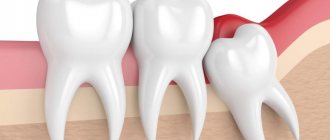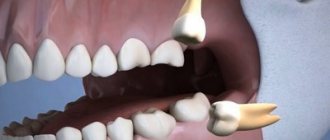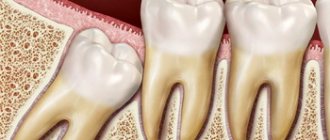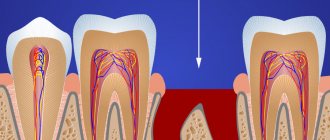How long does a wisdom tooth hurt as it grows?
If there is enough space for the “eight”, and the gum tissue is not particularly dense, the new tooth will grow quickly: in total, the suffering will last no more than 2 months. In this case, although the sensations will be unpleasant, they will be quite tolerable.
If the gums hurt very badly, swelling appears or the temperature rises, most likely there is an infection under the hood. This happens even with normal eruption of the third molar.
Does a wisdom tooth always hurt when it comes through?
When wisdom teeth erupt, 90% of people experience pain. And, probably, each of them is sincerely perplexed why, in childhood, teeth were replaced unnoticeably, without causing any discomfort. The answer is simple:
- firstly, in childhood, bone tissue is softer and more elastic;
- secondly, permanent teeth appear where baby teeth already existed.
But the “eights” have to literally win their right to life, cutting through the thickness of dense, healthy bone. It is for this reason that the upper wisdom teeth erupt less painfully - the bone of the upper jaw is less dense.
Dentists have long noticed that the later the “eights” begin to grow, the more pain they will cause to their owner. This is explained by the fact that the formation of human bone tissue is completed by the age of 25-27. And every year in her youth she becomes less and less pliable.
Read also
The gum under the tooth hurts
Gum inflammation
Inflamed and bleeding gums
If the pain suddenly overtakes a person, and he does not have the opportunity to visit the dentist at the moment, you can reduce the pain by following these recommendations:
- To avoid aggravating gum inflammation, do not apply warm compresses to it;
- to relieve the pain caused by a wisdom tooth, take 1-2 tablets of analgin, paracetamol or tempalgin;
- It is recommended to rinse your mouth with a weak solution of soda at room temperature;
- do not take anti-inflammatory drugs and antibiotics without a doctor’s recommendation;
- At the first symptoms of pericoronoritis, contact your dentist immediately.
It should be noted that all of the above methods only temporarily reduce gum inflammation caused by an erupting wisdom tooth, and in order to completely eliminate the causes of pain, the help of a professional dentist is necessary.
How long does a tooth hurt when there is a complication?
If the wisdom tooth does not grow in the required 60 days, something did not go according to plan. And in such cases, when talking about timing, dentists do not undertake to give any forecasts. Perhaps, with careful adherence to oral hygiene and constant monitoring by a doctor, the third molar will still grow in the near future.
But there is no less chance that the process will become chronic. Millions of people around the world experience excruciating exacerbations for years. The pain subsides for a while, but after a couple of months, and sometimes a couple of years, the tooth begins to cut again, and the pain returns with renewed vigor.
Periodontal diseases
Difficult access to the third molars does not allow them to be thoroughly cleaned of soft plaque, which very quickly turns into hard dental deposits. If the patient does not resort to professional teeth cleaning, the periodontal tissues surrounding the tooth will become inflamed - periodontitis will occur. This disease practically does not manifest itself for a very long time, and if left untreated, the infection spreads to the bone tissue, provoking the appearance of osteoperiostitis, better known as dental gumboil.
Why does a wisdom tooth hurt as it grows?
There are only 5 causes of such pathological, often unbearable, pain.
- Not enough space in the dentition .
Wisdom teeth are rudiments; we inherited them from our ancestors, whose jaw was 10-12 centimeters wider. Now, many people simply do not have room in their teeth to fit another tooth. But the “extra” molar is growing. And even if the direction of growth is correct, the impostor puts pressure on the teeth in front, moves them to the center and, in the end, wins back its place. This process, which occurs in the thickness of the bone, is very unpleasant and painful. And it ends with unaesthetic crowding of teeth. - Wrong direction of growth .
It is impossible to predict how a wisdom tooth will grow. If you're lucky, it will become clearly vertical. But very often its axis is deviated to the side. And then, at best, the tooth will scratch the gums, tongue or palate. At worst, it will begin to push the roots of the “seven”, inevitably destroying it. Pain due to dystopia, which is what dentists call the pathological direction of growth of the “eight”, is impossible to withstand without strong painkillers. It shoots and crushes, cuts and stabs, hits the ear and temple, not allowing you to forget for a second about the culprit of the torment. - Development of bacterial infection .
When the teething process drags on for months, or even years, a so-called “hood” forms over the wisdom tooth. It is formed by the gum covering the molar. Food debris inevitably gets into this fold, and the inability to maintain proper care leads to inflammation - pericoronitis. Its main symptom is an increase in body temperature, which can reach 400 C. In this case, the patient complains of constant aching pain, the inability to talk, eat, and sometimes even open his mouth. Upon examination, swelling and redness of the gums are clearly visible. - Trigeminal neuralgia .
Perhaps the most vivid sensations of pain were experienced by those people whose wisdom tooth once touched one of the branches of the trigeminal nerve. They provide sensitivity to facial tissues, soft tissues of the mouth and teeth. And if a wisdom tooth presses on a nerve, unbearable pain begins, affecting not only the jaw, but also the throat, ear, and head. The patient cannot even understand what hurts more. - Caries, pulpitis, periodontitis .
Just like other teeth, the third molar can become diseased. More often this happens with an already erupted tooth. But sometimes an infection that gets under the hood affects not only the soft tissues, but also the wisdom tooth itself. And then the dentist will have to decide whether it is worth treating the disease, or whether it is easier to immediately remove the third molar.
Wisdom teeth removal with 20% discount
Moscow
Impacted third molars
- Lack of space leads to abnormal placement of the tooth in the jaw arch. Impacted teeth can grow towards the cheek and constantly injure its mucous membrane.
- In the absence of an antagonist in the opposite jaw, they cause serious malocclusion, ultimately leading to imbalance of the masticatory muscles, pinched nerve endings, dysfunction of the temporomandibular joint and even neurological disorder.
- A tooth that does not come out of the bone often provokes the formation of a follicular cyst, which does not manifest itself for a long time. This is explained by the presence of remnants of a follicle around it, the cells of which, for as yet unknown reasons, begin to multiply. The roots of the adjacent molar often get into the lumen of the cyst. This leads to necrosis of their pulp and necessitates the treatment of pulpitis and depulpation of the tooth.
- The third molar can put pressure on the roots of the second, causing headaches, soreness in the ear or throat.
In what cases is it better to remove a tooth?
Old school dentists insist that at the first discomfort of the patient, wisdom teeth should be removed without regret. Modern dentistry is more humane and is convinced of the need for strict indications for the procedure, rightly noting that in due time “eights” may become the only possible support for dentures.
Indications for removal are:
- eruption of the third molar outside the dentition;
- threat of displacement of adjacent teeth;
- abnormal position of the crown and pressure on the second molar;
- impossibility of therapeutic treatment of the tooth.
Today, at the first visit with complaints of pain caused by the “eight”, the dentist first takes an x-ray to examine the position of the roots, the shape of the tooth and its condition. And only then evaluates all the risks. With this approach, a wait-and-see tactic is increasingly being chosen: the doctor selects painkillers that will help survive the pain that is natural to the teething process. If necessary, incises the gum and cuts off the hood. And then for several months he observes how the wisdom tooth will behave.
Dentists of the Israeli school even fight for impacted wisdom teeth, pulling them out and putting them in the right place with the help of orthodontic instruments. The main thing is that there is enough space in the patient's jaw.
Is it painful to have a wisdom tooth removed?
26% of operations to remove “eights” are no different from the removal of other molars. The wisdom tooth is simply pulled out using hand forceps after local anesthesia is administered. In this case, the patient, as a rule, does not even have time to get scared, the whole procedure goes so quickly.
Another thing is difficult removal. This operation can last up to 40 minutes, during which the surgeon saws the tooth with a drill and takes it out in parts. Unfortunately, this is the only way to remove a tooth that lies horizontally, or has frozen in its development, and has not erupted, but due to its location causes constant pain.
And even in this case, modern anesthesia can completely relieve pain. The same applies to the recovery period. First, in most cases, the surgeon will stitch up the resulting wound, speeding up the healing process. Secondly, he will prescribe painkillers for the coming days. Therefore, you should not be afraid of removal - it will cause much less pain than regular exacerbations.
Specialist help
In case of inflammation of the gingival tissues around the eights, the best solution is to immediately visit a dentist. The specialist will conduct an x-ray and a visual examination of the condition of the tooth and the surrounding area. Based on the examination results, competent treatment will be prescribed:
- Medication - by prescribing antihistamines and anti-inflammatory drugs, antibiotics, special ointments and gels, antiseptic baths.
- Surgical - cutting the gum or gingival hood, removing the figure eight that caused the problem.
If inflammation is accompanied by unbearable acute pain and severe swelling of the gums, a specialist performs a novocaine blockade. Sometimes laser therapy is prescribed, which has an anti-inflammatory effect on the affected area.
How to relieve pain?
At the first unpleasant sensations from a growing wisdom tooth, frequent rinsing with Chlorhexidine, Miramistin or Eludril solution helps. If you can’t run to the pharmacy, you can prepare a soda-salt solution: dissolve 1 teaspoon of soda and salt in one glass of warm boiled water.
Supporters of traditional methods can use oak bark, sage and chamomile. To do this, you need to take 3-4 tablespoons of the mixture, composed in equal proportions, and pour 500 ml of boiling water. Leave for an hour and strain before using.
Rinses are effective only if the pain is caused by the natural process of tooth eruption. All of the listed drugs, both pharmaceutical and home-made, relieve swelling well and suppress the activity of pathogenic microflora in the oral cavity.
If symptoms of an attached infection have already developed: fever, swelling, severe swelling, surgical intervention will most likely be required: removal of either the hood or the tooth itself. In order to reduce the risk of complications, the doctor will definitely prescribe antibiotics.
Please note: it is strictly forbidden to prescribe antibiotics to yourself!
But painkillers should be taken before visiting the doctor. In this case, the following are effective:
- Broad spectrum analgesics
. Analgin, Ketanov, Paracetamol relieve pain for several hours, usually from 1 to 5. It is also possible that the tablet will not work at all. You can increase the dose, the main thing is to strictly follow the instructions. - Anti-inflammatory drugs.
Nurofen, Ibuprofen, Diclofenac can not only provide a powerful analgesic effect, but also relieve fever and reduce swelling. - Ointments, gels, sprays for topical use
. Holisal, Metrogyl Denta, Kamistad, Angilex “freeze” any sensations in the sore gum for 2-3 hours.
An ordinary piece of ice relieves pain well. It needs to be wrapped in a cloth and applied to the external projection of the diseased tooth on the cheek. Hold for no more than 5-7 minutes. Do not put ice directly on the gum. Its tissues are too delicate and direct contact can lead to necrosis.
The most original folk method of getting rid of toothache when a wisdom tooth comes out: take a plantain leaf, wash it and roll it into a tube. Then you need to insert the sheet into the auricle, but always on the side on which the tooth hurts. Dentists call such methods useless. But this method does not cause any harm. So why not try?!










